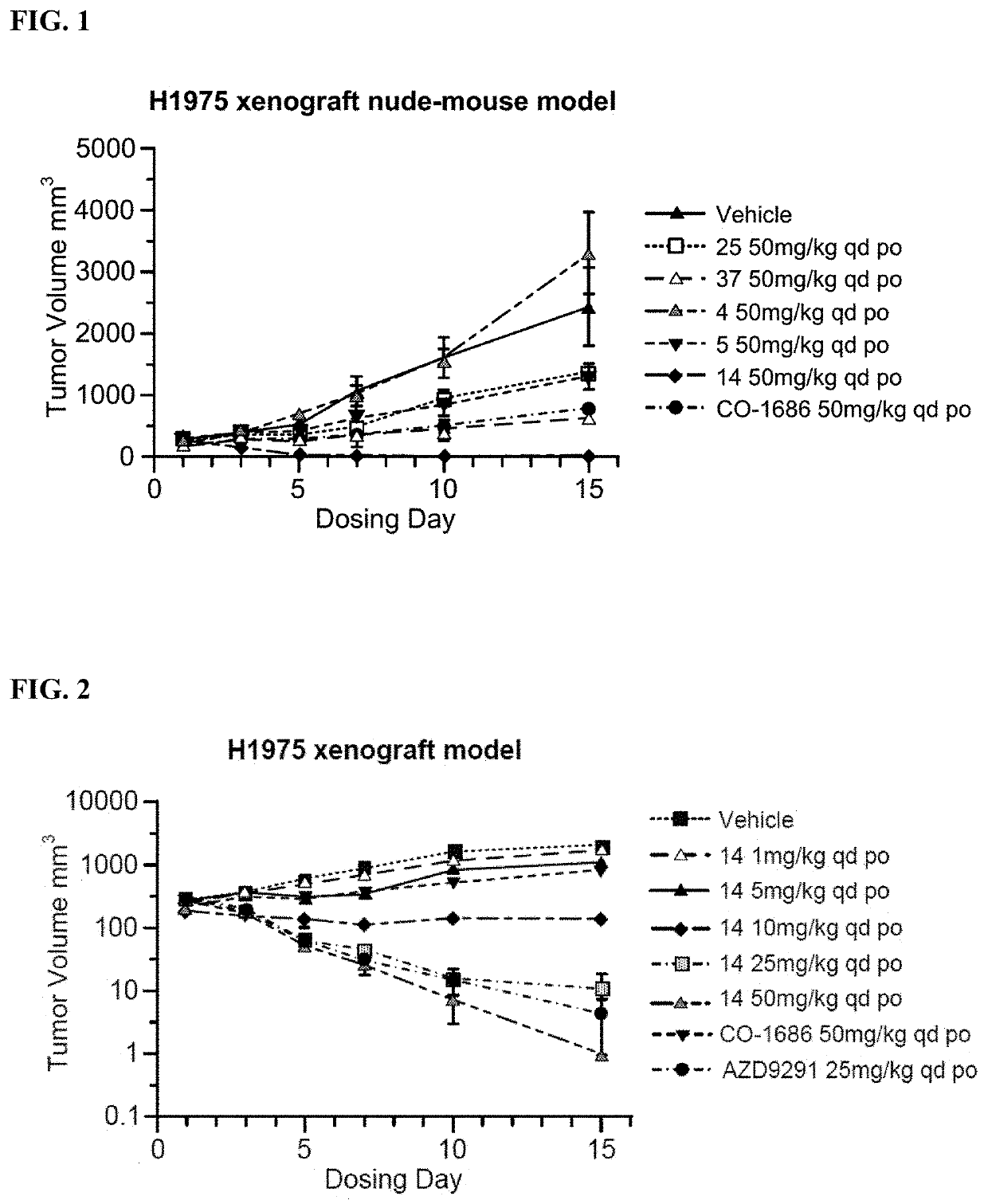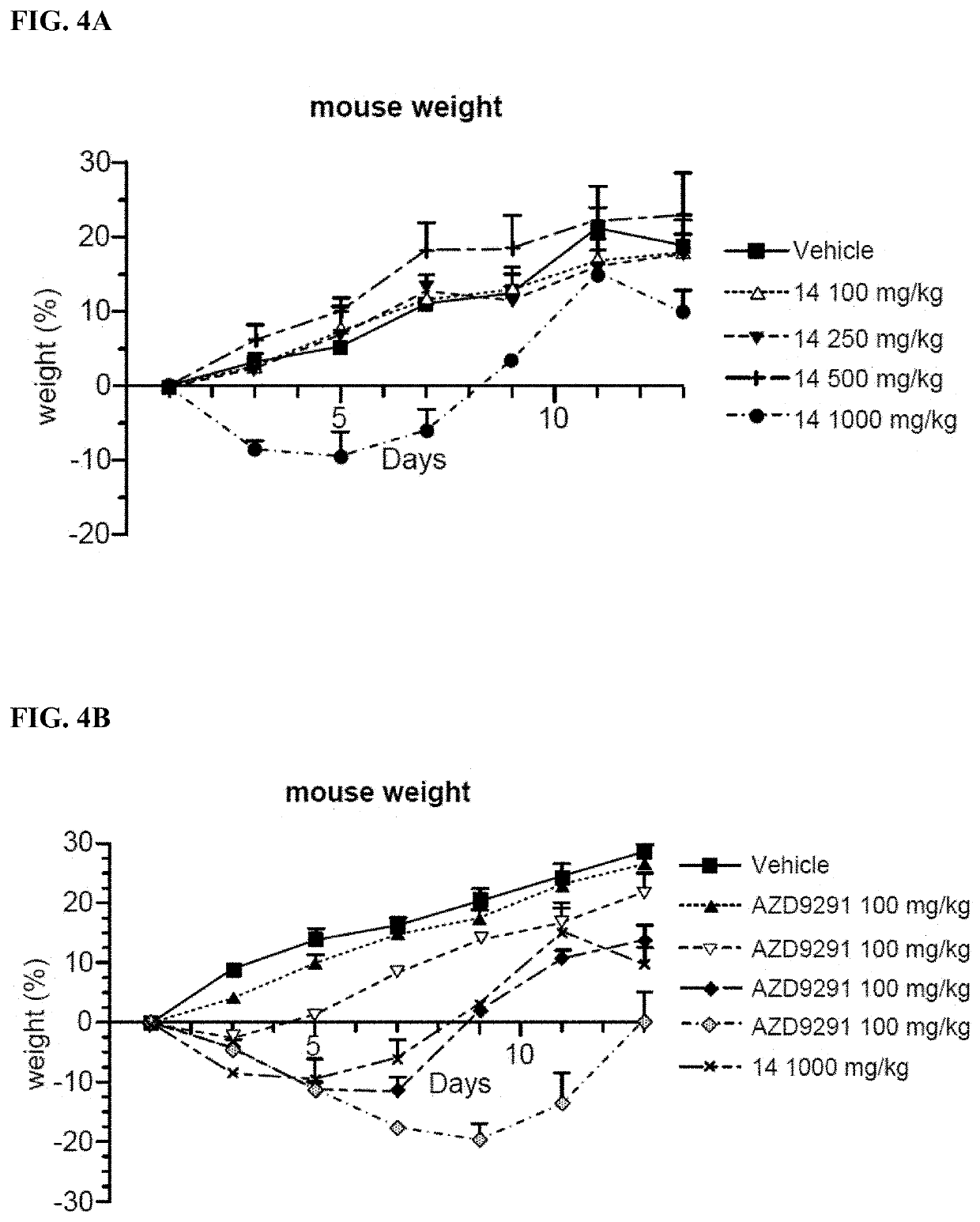Use of pteridinone derivative serving as EGFR inhibitor
a technology of pteridine and derivative, applied in the field of pteridine derivatives, can solve the problems of reducing the sensitivity of patients to drugs, reducing the quality of life of cancer patients, and low maximal tolerated dose (mtd) of drugs, and achieve good druggability
- Summary
- Abstract
- Description
- Claims
- Application Information
AI Technical Summary
Benefits of technology
Problems solved by technology
Method used
Image
Examples
example
Example 1
[0115]The particular method for steps a-f as said above is shown as follows:
Synthesis of tert-butyl (3-(2-chloro-5-nitropyrimidyl-4-amino)phenyl)carbamate
[0116]
[0117]2,4-dichloro-5-nitro-pyrimidine (3.80 g, 19.59 mmol) was placed into a 100 mL round bottom flask, 80 mL of 1,4-dioxane was added, and stirred at room temperature. Tert-butyl (3-aminophenyl) carbamate (4 g, 19.21 mmol) and N,N-diisopropylethylamine (2.98 g, 23.05 mmol) were dissolved in 20 mL of 1,4-dioxane. The resulting solution was added dropwise into the reaction solution as said above. Upon completion of addition, the resulting mixture was stirred at room temperature for 0.5 h, and TLC showed that the raw material was completely conversed. The solvent was removed by rotary evaporation, and the crude product was separated through silica gel column chromatography (petroleum ether / ethyl acetate=10:1, v / v) to obtain tert-butyl (3-(2-chloro-5-nitropyrimidyl-4-amino)phenyl)carbamate as orange solids (5.9 g, yield...
example 2
[0244]Assay on Bioactivity: Activity Test on Molecular Level (Kinase)
[0245]EGFR-TK catalyses transfer of one phosphate group of adenosine triphosphate (ATP) to polypeptide substrate, poly(Glu, Tyr)4:1, which is labeled with two fluorescent groups coumarin and fluorescein. Based on fluorescence energy resonance transfer (FRET) method, EGFR-TK catalyzes a reaction of ATP, resulting in two fluorescent groups approaching, exciting donator (coumarin) at 400 nM, releasing part of energy (emission wavelength at 445 nM), and transferring other part of energy to fluorescein (emission wavelength at 520 nM). Different compounds exhibited different inhibition-degrees on EGFR-TK, leading to different phosphorylation-degrees of substrate, so that the inhibition ratio of different compounds can be calculated by measuring the ratio of phosphorylation percentage of substrate catalyzed by an enzyme.
[0246]1. Experiment Steps:
[0247]2.5 μL of Test Compounds, 5 μL Kinase / Peptide Substrate Mixture, 2.5 μL...
example 3
[0252]Cell Activity Test (Inhibitory Activity on Cell Proliferation)
[0253]Inhibition Analysis on Cell Proliferation and Growth: H1975 (non-small cell lung cancer cells, EGFRL858R / T790M), A431 (non-small cell lung cancer cells, EGFR wild type) cells were obtained from the ATCC. Cell proliferation activity was assessed by MTS assay. Cells were exposed to processing conditions for 72 hours and the number of cells used in each experiment for each cell line was adjusted based on absorbance values (absorbance values at 490 nm, 1.3-2.2). Six concentration gradients (0.1 nM-10 μM) were set for the compounds to be tested, wherein at least 6 sets of parallel controls for each concentration were used.
[0254]H1975, A431 cells were cultured in corresponding media, and cells were passaged at least twice after resuscitation and then used for experiments. Cells at Log phase were trypsinized and resuspended in culture medium. H1975 (1000 cells per well), A431 (2000 cells per well) were seeded in 96-w...
PUM
| Property | Measurement | Unit |
|---|---|---|
| solubility | aaaaa | aaaaa |
| emission wavelength | aaaaa | aaaaa |
| emission wavelength | aaaaa | aaaaa |
Abstract
Description
Claims
Application Information
 Login to View More
Login to View More - R&D
- Intellectual Property
- Life Sciences
- Materials
- Tech Scout
- Unparalleled Data Quality
- Higher Quality Content
- 60% Fewer Hallucinations
Browse by: Latest US Patents, China's latest patents, Technical Efficacy Thesaurus, Application Domain, Technology Topic, Popular Technical Reports.
© 2025 PatSnap. All rights reserved.Legal|Privacy policy|Modern Slavery Act Transparency Statement|Sitemap|About US| Contact US: help@patsnap.com



